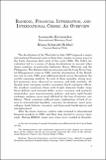Artículo
Banking, financial integration, and international crises: an overview
Fecha
2002Resumen
The devaluation of the Thau bath in July 1997 triggered a major international financial crisis in East Asia, similar in many ways to the Latin American debt crisis of the early 1980s. The baht´s devaluation led to a Seriesos sharp devaluations in several other Asian countries, in particular Indonesia, Korea, Malaysia, and the Philippines. The Russian debt moratorium and the long term capital management crisis in 1998, and the devaluation of the Brazilian real in early 1999, sent additional shock waves throughout the world's emerging markets. In each of these episodes, strong market pressures were observed in currency and cebt markets. Although most emerging market economies faced contagion effects, the weakest countries -those with fragile domestic banks, large fiscal deficits and external debts, severe currency and maturity mismatches, poor macroeconomic policies, and more rigid foreingn exchange regimes- were most affected by the loss of investor confidence. These countries suffered some combination of lack of access to international liquidity, currency devaluation, asset price collapse, bank failures, recession, and large-scale bankruptcies and unemployment.
Colecciones
Descargar


